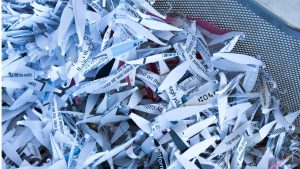
The simple answer is whenever you are throwing away any documents with private or proprietary information. Now let’s explore this in greater detail.
Data privacy and security are paramount today more than ever because of the great number of unscrupulous people around the world trying to steal your information. Properly managing your documents is crucial. Shredding documents is a fundamental aspect of safeguarding sensitive information, preventing identity theft, and ensuring compliance with data protection regulations. But the question remains: how often should you shred documents? In this blog post, we’ll explore the factors that influence document shredding frequency and provide practical guidelines to help you keep your information secure.
Legal Requirements For Shredding
One of the primary factors that dictate how often you should shred documents is legal requirements. Depending on where you live and the nature of your business or personal activities, you may be subject to specific regulations governing document retention and disposal. These laws often specify retention periods for different types of documents.
For instance, the Data Protection Regulations like HIPAA, GLB and FACTA mandates that certain personal data must be securely disposed of once it’s no longer needed. Failure to comply with these regulations can result in severe penalties, so it’s essential to familiarize yourself with the specific legal requirements in your jurisdiction and industry.
Document Type
Different types of documents have varying retention periods. Here are some common document categories and their recommended shredding frequencies:
Financial Documents
Bank statements, tax records, and receipts should be shredded annually after you’ve verified their accuracy. However, it’s wise to retain tax records for at least seven years after the date you file the return for tax purposes.
Medical Records
Medical bills, insurance documents, and other health-related records should be shredded once they are no longer needed for medical reasons, insurance claims or tax deductions. Check with your healthcare provider or insurer for specific guidelines.
Personal Identifiable Information (PII)
Any document containing sensitive personal information, such as Social Security numbers, driver’s licenses, or passport copies, should be shredded immediately after it’s no longer needed.
Business Documents
Businesses should follow industry-specific regulations for document retention and disposal. Generally, financial records, contracts, and personnel records should be retained for several years before shredding. Also, all proprietary information like price sheets, customer lists, sales materials, formulas and specifications should be shredded when no longer needed to prevent them from getting in your competitor’s hands.
Individual Risk Assessment
Your personal or business risk tolerance plays a crucial role in determining shredding frequency. Consider the potential consequences of a data breach or identity theft. If you’re risk-averse, you may choose to shred documents more frequently than recommended guidelines to minimize the chance of sensitive information falling into the wrong hands.
Record Storage Capacity
The amount of space you have available for document storage can also impact shredding frequency. If you have limited space and are struggling to manage stacks of paperwork, it might be time to purge unnecessary documents and shred them.
Digital Alternatives
Many documents are stored electronically. Whenever possible, documents and information that is electronically stored should be on encrypted and password-protected devices or in cloud storage. This can reduce the need for physical document storage and shredding while enhancing data security.
Conclusion
Determining how often you should shred documents involves a combination of legal requirements, document type, risk assessment, and practical considerations. Regularly reviewing your documents and disposing of sensitive information when it’s no longer needed is a key component of data security and privacy. Consider having a shred-all policy to securely destroy every document being disposed of to reduce the likelihood of a data breach dramatically.
By
Jim Dowse CSDS


